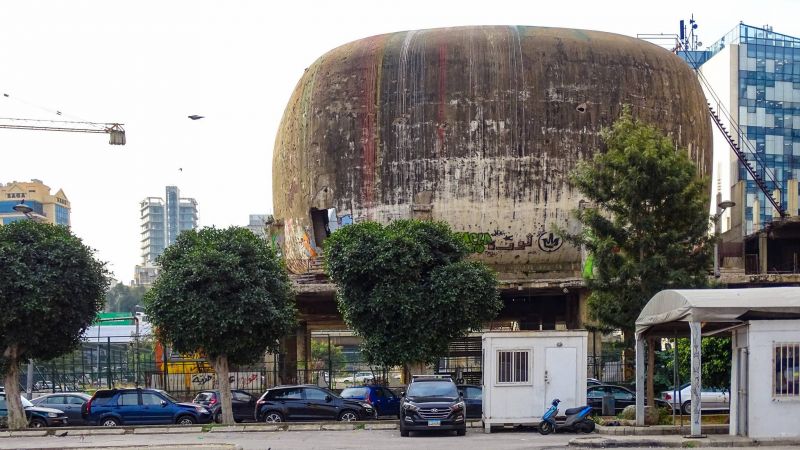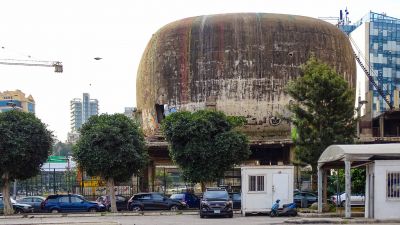
Beirut's Egg became a symbol of broken promises and frustrated hopes during the October 2019 Revolution. (Credit: Camille Ammoun/L'Orient-Le Jour)
Instrumentalized and absorbed by the political, financial and clerical classes, the five “powers” that govern and feed the Lebanese corruptocracy are all geographically concentrated and physically represented in Beirut's empty center. There is the real estate power through Solidere and the Georges Haddad Street urban scar; the financial power through the headquarters of the Association des Banques du Liban and the Banks street; the religious power through the multiple houses of worship scattered throughout the area; the legislative power with the Parliament; and, finally, the executive power with the Grand Serail.
Across Georges Haddad street, past the Association des Banques du Liban, over the great parking lot of the Martyrs, there, at the point where the General Gouraud gives way to the Emir Bechir, stand two stone colossi: St. George Maronite Cathedra, inspired by the Basilica of St. Mary Major in Rome and consecrated on Palm Sunday in 1894; and the great Mohammad al-Amin Mosque of monumental Ottoman style, inspired by the Blue Mosque in Istanbul and inaugurated 114 years later on an October day in 2008.
Only here, in the depopulated heart of Beirut, are the Eternal City and the Sublime Porte so close that only a narrow alley separates them. But these two immense places of worship are also the physical manifestations of a power that is ultimately much more temporal than spiritual since it is exercised in complete coherence with the communitarian oligarchy. It interferes with minds, bodies and behaviors.
Opposite St. George and Mohammad al-Amin stands a third, secular, temple, a place of creation and circulation of knowledge. The rounded forms of this monumental, hollow megalith contrast the angular and erect belfries of the other two giants. Designed by architect Joseph Philippe Karam in 1965, the Egg was intended to be part of a multi-purpose urban complex: the Beirut City Center. Since its construction, it has accompanied Beirut in its different phases: before 1975 it was used as a theater; during the 15 years of the armed conflict the building was used as a bunker by militiamen; after 1990 it was recovered by the civil society and turned into a public cultural space hosting experimental events, exhibitions and raves.
Today, the Egg is once again inaccessible. In the Lazarists parking lot, among pigeons and cars, hovers the memory of October 2019's great agora. The main civil society organizations had set up tents and organized debates and conferences on all sorts of topics related to the demands of the revolution: the circuits of corruption, the debt crisis, depositors' rights, the recovery of stolen goods, fear in times of revolution, the independence of justice, the curse of natural resources, the confiscation of public space ... For months, knowledge circulated and the revolution became a university. The Egg, this large, squatted pebble still riddled with the shell craters of 1975 was then used as an amphitheater. Worried people expressed pent-up anger, repressed and frustrated by 40 years of organized looting of the country by its ruling class.
During the memorable days of October 2019, the walls spoke. And they did not always agree. From “eat the rich” to “free your pussy,” to all sorts of “get out,” “kellon yaani kellon,” "insult is a right" and other “helaho” songs, the most inventive and demanding slogans sprang up. A wall, belonging to one of the two big houses of worship in Beirut Square (whether it was the al-Amin Mosque or Saint George's Cathedral was of little importance), singularly illustrated the dialogue the October movement was holding with itself:
First level: A tag made illegible by a spot of white paint, probably covered by demonstrators who wished to preserve the sacredness of the place.
Second level: On the spot of white paint, a painted text, “THIS WALL IS A WALL LIKE ANY OTHER.”
Third level, “THIS WALL IS “NOT” A WALL LIKE ANY OTHER,” the "not" added by hand.
During the days of October 2019, the crowd held a dialogue with itself. It desecrated without profanity. It denounced the collusion between the leaders of religious communities and the oligarchs in power. It asked for the separation between religious institutions and the state. Elsewhere, on other walls, it called for the advent of a secular state and, above all, for an end to the political confessionalism used by the traditional zaimsDuring the days of October 2019, the crowd held a dialogue with itself. It desecrated without profanity. It denounced the collusion between the leaders of religious communities and the oligarchs in power. It asked for the separation between religious institutions and the state. Elsewhere, on other walls, it called for the advent of a secular state and, above all, for an end to the political confessionalism used by the traditional zaims as a scarecrow to win the loyalty of their flock.
The gap between the different groups that occupied the streets in October 2019 is sometimes immense. During a debate on gender equality, for example, organized in one of the tents in the Lazarist parking lot, opponents of the secularization of personal law accused the organizers of being "a Western product aimed at destroying the Lebanese family.” This, of course, disturbs the progressive bien-pensance, but proves that the source of all evils – the corruption of Lebanon's political class – mobilizes all people it affects.
The laws governing personal status — ie all matters relating to the person or the family such as marriage, divorce, filiation and inheritance — are managed by the 18 Lebanese religious communities through codes that source their justice from their various ancestral rights. Each community has its own laws, judges, and courts. None of these codes advocate equality between women and men. Where there should be total and indisputable equality before a single republican law, these codes create legal and social differences between citizens of the same country, according to their community and gender. In identical cases, male and female citizens of the same country are judged differently according to the community to which they belong, sometimes in a contradictory manner and, all too often, to the detriment of the citizen. These community codes,
The demand for equality of men and women under the law is, of course, an end in itself. But it is also a means to loosen the grip of communal politics and its traditional structures on the daily life of the Lebanese—a first step towards the renewal of the political class. What if only a radical approach of contestation can shake the Lebanese patriarchal and communal system? What if the only way to separate religion from the state is to demand a separation of gender and state?
This article was originally published in French in L'Orient-Le Jour.
